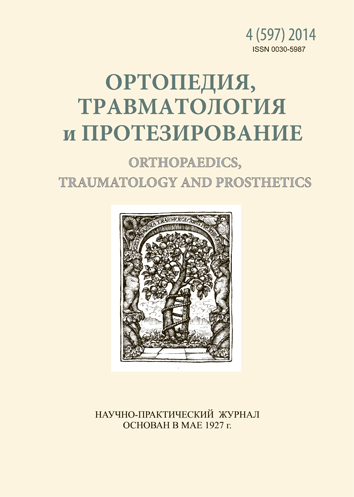Evolution of metal constructs in orthopedic surgery of osteogenesis imperfecta
DOI:
https://doi.org/10.15674/0030-59872014475-79Keywords:
osteogenesis imperfecta, intramedullary telescopicconstructs, surgical treatmentAbstract
Objective: To improve outcomes of surgical treatment of bone deformities in children with osteogenesis imperfecta. Methods: At the Department of Traumatology and Orthopedics for Childhood of the SI «ITO NAMSU» treated 11 patients with osteogenesis imperfecta. We performed 23 surgeries with the use of intramedullary «growing» telescopic constructs to correct thighs and shin deformities. Results: In 9 patients for the correction of axial deformities of the lower limbs we used for osteosynthesis «growing» telescopic constructs. Their advantage is as follows: prevention of repeated fractures and bone deformities, and their disadvantages are as follows: danger of the rotational displacement for bone fragments and their displacement in length as well as inability to create compression in the osteotomy region. In this regard, in 2 patients we used an improved surgical procedure. On the first stage we performed corrective osteotomy and intramedullary nailing with locking rod and the distal part of the T-shaped telescopic component; on the second one locking screws were removed and construction was transferred into the «growing» kind after fusion of the fragments. In all cases fusion was obtained in due course. There was no violation of bone growth in length, repeated fractures and deformities. In one patient fixateur was replaced due to the divergence of its elements, in one more patient fixed bone pseudosarkoma ostoperatively. Conclusion: an improved method for the surgical treatment of bone deformities using intramedullary telescopic construct which is based on association of the principles of blocking compressive osteosynthesis and intramedullary osteosynthesis with «growing» telescopic rod is effective in cases of osteogenesis imperfecta and is accompanied by a low complication rate.
References
- Hyperplastic callus formation in osteogenesis imperfecta / H. W. Lehmann, A. Nerlich, R. E. Brenner [et al.] // Eur. J. Pediatr. Surg. — 1992. — Vol. 2 (5). — P. 281–284.
- Sillence D. Osteogenesis imperfecta: Anex panding panorama of variants / D. Sillence // Clin. Orthop. Relat. Res. — 1981. — Vol. 159. — Р. 11.
- Van Dijk F. S. Osteogenesis imperfecta: clinical diagnosis, nomenclature and severity assessment / F. S. Van Dijk, D. O. Sillence // Am. J. Med. Genet. — 2014. — Vol. 164-A (6). — P. 1470–1481, doi: 10.1002/ajmg.a.36545.
- Esposito P. I. Surgical treatment of osteogenesis imperfecta: current concepts / P. I. Esposito, H. Plotkin // Curr. Opin. Pediatr. — 2008. — Vol. 20 (1). — Р. 52–57, doi: 10.1097/MOP.0b013e3282f35f03.
- Osteogenesis imperfecta: practical treatment guidelines / F. I. Antoniazzi, M. Mottes, P. Fraschini [et al.] // Paediatr. Drugs. — 2000. — Vol. 2 (6). — Р. 465–488.
- Brunelli P. C. Complications of elongating intramedullary rodding in osteogenesis imperfecta / P. C. Brunelli, P. Novati // Am. J. Med. Genet. — 1993. — Vol. 45. — P. 275.
- Mulpuri K. I. Intramedullary rodding in osteogenesis imperfecta / K. I. Mulpuri, B. Joseph // J. Pediatr. Orthop. — 2000. — Vol. 20 (2). — Р. 267–273.
- Joseph B. I. The choice of intramedullary devices for the femur and the tibia in osteogenesis imperfecta / B. I. Joseph, G. Rebello // J. Pediatr. Orthop. — 2005. — Vol. 14-B (5). — Р. 311–319.
- Karbowski A. I. Experiences with different telescope nails in treatment of pediatric osteogenesis imperfecta / A. I. Karbowski, M. Schwitalle, A. Eckardt // Zentr. Chir. — 1998. — Vol. 123 (11). — Р. 1252–1256.
- Use of the Sheffield telescopic intramedullary rod system for the management of osteogenesis imperfecta: clinical outcomes at an average follow-up of nineteen years / N. I. Nicolaou, J. D. Bowe, J. M. Wilkinson [et al.] // J. Bone Joitn Surg. — 2011. — Vol. 93-A (21). — Р. 1994–2000, doi: 10.2106/JBJS.J.01893.
- Jerosch J. I. Complications after treatment of patients with osteogenesis imperfecta with a Bailey-Dubow rod / J. I. Jerosch, I. Mazzotti, M. Tomasevic // Arch. Orthop. Trauma Surg. — 1998. — Vol. 117 (4–5). — Р. 240–245.
- Fassier-Duval femoral rodding in children with osteogenesis imperfecta receiving bisphosphonates: functional outcomes at one year / J. Ruck, N. Dahan-Oliel, K. Montpetit // J. Child. Orthop. — 2011. — Vol. 5 (3). — Р. 217–224, doi: 10.1007/s11832-011-0341-7.
- Laidlaw A. T. I. Telescoping intramedullary rodding with ailey-Dubow nails for recurrent pathologic fractures in children without osteogenesis imperfecta / A. T. I. Laidlaw, R. T. Loder, R. N. Hensinger // J. Pediatr. Orthop. — 1998. —Vol. 18 (1). — Р. 4–8.
Downloads
How to Cite
Issue
Section
License
Copyright (c) 2014 A. Krys-Pugach, A. Zyma, Yu. Guk, T. Kincha-Polishchuk, S. Martsynyak, A. Chewerda, A. Zotya

This work is licensed under a Creative Commons Attribution 4.0 International License.
The authors retain the right of authorship of their manuscript and pass the journal the right of the first publication of this article, which automatically become available from the date of publication under the terms of Creative Commons Attribution License, which allows others to freely distribute the published manuscript with mandatory linking to authors of the original research and the first publication of this one in this journal.
Authors have the right to enter into a separate supplemental agreement on the additional non-exclusive distribution of manuscript in the form in which it was published by the journal (i.e. to put work in electronic storage of an institution or publish as a part of the book) while maintaining the reference to the first publication of the manuscript in this journal.
The editorial policy of the journal allows authors and encourages manuscript accommodation online (i.e. in storage of an institution or on the personal websites) as before submission of the manuscript to the editorial office, and during its editorial processing because it contributes to productive scientific discussion and positively affects the efficiency and dynamics of the published manuscript citation (see The Effect of Open Access).














